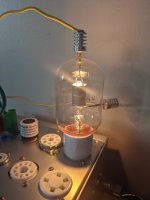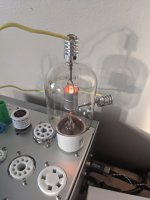I think so. There are probably a lot of good Russian tubes to be found as well.
The 327A and VT127A tubes I'm using were used in US ship radars in WWII.
The 327A and VT127A tubes I'm using were used in US ship radars in WWII.
GMI-30 looks a lot like one of the tubes you have been playing with.
VT127-A have uranium lead ins, harmless stuff but still cool.
Elton Britt - Uranium Fever - YouTube
VT127-A have uranium lead ins, harmless stuff but still cool.
Elton Britt - Uranium Fever - YouTube
GMI-30 looks to be a clone of the 6C21, which I'm guessing was probably a descendant of the 100T.
Edit: I've got plans for UV LEDs to light up the uranium glass.
Edit: I've got plans for UV LEDs to light up the uranium glass.
Correction, it looks like the grandfather of that tube design would be the 150T, which was the first tube from Eimac.
I have been collecting HK54 / 35T / 35TG for a design. They are uncommon, so I've bought a few a untested at low prices. Success rate for the untested tubes is low as you might expect.
Would it be accurate to say that tubes that have a healthy filament and are slightly gassy are worth holding onto for the sake of baking, whereas those with an unhealthy filament are not?
Here is one HK54 in my tracer, filament looks good but there is slight gas, I think it might be salvageable. This is a pulse tracer, so it will not activate the getter.

Here is another with a dim filament as an example, I assume these are not worth trying to save.

Would it be accurate to say that tubes that have a healthy filament and are slightly gassy are worth holding onto for the sake of baking, whereas those with an unhealthy filament are not?
Here is one HK54 in my tracer, filament looks good but there is slight gas, I think it might be salvageable. This is a pulse tracer, so it will not activate the getter.

Here is another with a dim filament as an example, I assume these are not worth trying to save.

Can you judge the filament by how much it shines? That seems quite unreliable to me.
I would check filament current/voltage versus the data sheet values/range.
Jan
I would check filament current/voltage versus the data sheet values/range.
Jan
Post #50 would suggest that you can, my experience has been tubes with a dim filament are gassy, the glass gets scorching hot as heat is transferred in the poor vacuum. Voltage for the rated current is low relative to the datasheet. It is a 5V / 5A filament, only dropping 2.5V at 5A. Probably obvious that the tube cannot be saved, just need confirmation before I throw away three or four of these with dim filaments, my inner hoarder is crying.
A 5V 5A filament that draws already 5V with 2.5V, that definitely seems broken.
My point was that 'dimness' is arbitrary - my 'too dim' maybe your 'still good'.
Jan
My point was that 'dimness' is arbitrary - my 'too dim' maybe your 'still good'.
Jan
I've not had any with dim filaments. Some of my 826s had smoke come off the filament as soon as I powered the filament, meaning that there was a total loss of vacuum in that tube. Those can't be salvaged.
I'd go by the curves (as long as your tracer has some sort of current limit protection). That should tell the story of the tube's performance.
I made a variable DC supply that goes up to 1000V with a variac, transformer, and bridge rectifier/cap. Then I got some big power resistors for current limiting.
I bring the voltage up slowly with an appropriate voltage on the grid (0V for a lot of tubes) and see if current seems right. With tubes that are slightly gassy, the gas will ionize at some point and the tube current will suddenly increase a lot. Plate voltage will drop when this happens if you have current limiting resistors.
The slightly gassy tubes that I have successfully rescued had a blue gas cloud and then cleaned up within 10 minutes. The gas ionized at less than 100V. The ones that never got better after 20+ hours of baking glowed more of a purple color and ionized closer to 400V. After all that baking, there was actually some black material that left the anode and is loose in the bulb.
I'd go by the curves (as long as your tracer has some sort of current limit protection). That should tell the story of the tube's performance.
I made a variable DC supply that goes up to 1000V with a variac, transformer, and bridge rectifier/cap. Then I got some big power resistors for current limiting.
I bring the voltage up slowly with an appropriate voltage on the grid (0V for a lot of tubes) and see if current seems right. With tubes that are slightly gassy, the gas will ionize at some point and the tube current will suddenly increase a lot. Plate voltage will drop when this happens if you have current limiting resistors.
The slightly gassy tubes that I have successfully rescued had a blue gas cloud and then cleaned up within 10 minutes. The gas ionized at less than 100V. The ones that never got better after 20+ hours of baking glowed more of a purple color and ionized closer to 400V. After all that baking, there was actually some black material that left the anode and is loose in the bulb.
My point was that 'dimness' is arbitrary - my 'too dim' maybe your 'still good'.
Point taken Jan, thanks.
I've not had any with dim filaments. Some of my 826s had smoke come off the filament as soon as I powered the filament, meaning that there was a total loss of vacuum in that tube. Those can't be salvaged.
I had something similar happen to one of the dim HK54, filament smoked, flashed, and was pulverized. I think the dim filament phenomenon is a loss of vacuum, the tubes do not conduct at all, I'll just toss them. I'll try baking those with a bright filament that are slightly gassy, thanks.
I didn't try operating the 826s that smoked any more than a few seconds. Maybe the filament would have dimmed with time if I had. Maybe it was more dim and I didn't notice.
Gotcha, I picked up some 5V 50W SMPS's for the filaments, will make a HV DC supply paired with a variac and bake 'em, thanks for the idea!
I just happened to have an Edcor power transformer laying around and then I built a doubler so I could get up to 1000V or so. Needless to say, I don't touch anything while it is running except the Variac knob. All probes are set up before I power up and I keep my hands well away from everything. Same goes for my transmitter tube amp prototype.
- Home
- Amplifiers
- Tubes / Valves
- Transmitter Tube Testing